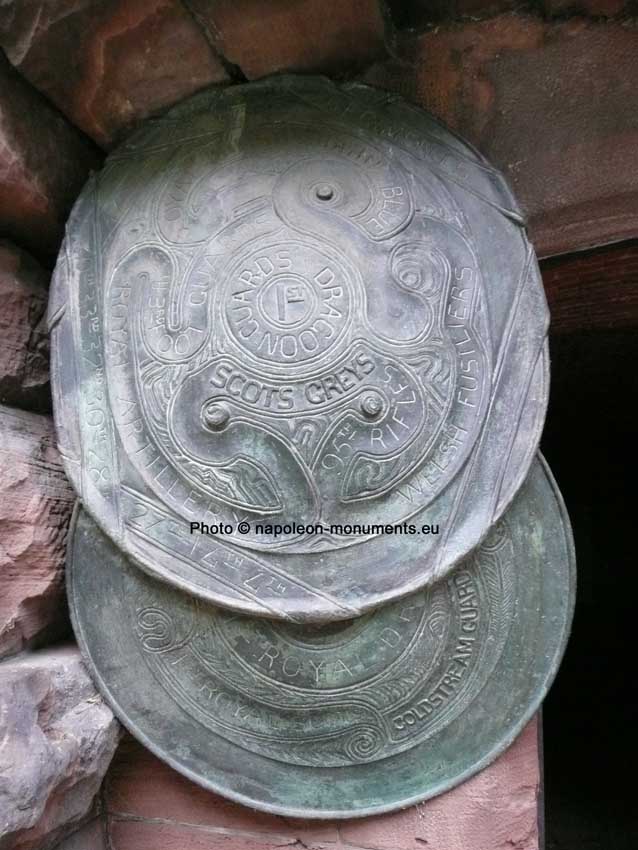The Brussels cemetery at Evere
The British monument

The idea of regrouping the tombs of the British officers killed in 1815
campaign was for the first time launched 18611,
unsuccessfully, and again in 1882. On 26 June 1882, the Brussels Major
Buls
makes a proposal of providing a concession to bury the British officers of the Waterloo campaign, buried
until then in many different places. * The City Council later
approves this proposal and a concession of 30 square meters is provided for
the erection of a monument to the officers and NCO's buried in the old cemeteries
of Brussels, Saint-Gilles, Waterloo, as well as at Mont-Saint-Jean, Hougoumont
and Quatre Bras. In 1888, the British decide to build a prestigious monument.
The subscription launched for that purpose bears the name "FUND FOR
REINTERRING AND ERECTING A MONUMENT OVER THE REMAINS OF THE BRITISH OFFICERS
AND MEN WHO FELL DURING THE WATERLOO CAMPAIGN"*.
The project is entrusted to the Belgian artist Jacques de Lalaing. The monument
is officially unveiled on the 26th of August 1890 and the remains are
transferred from 1890 until 1894.
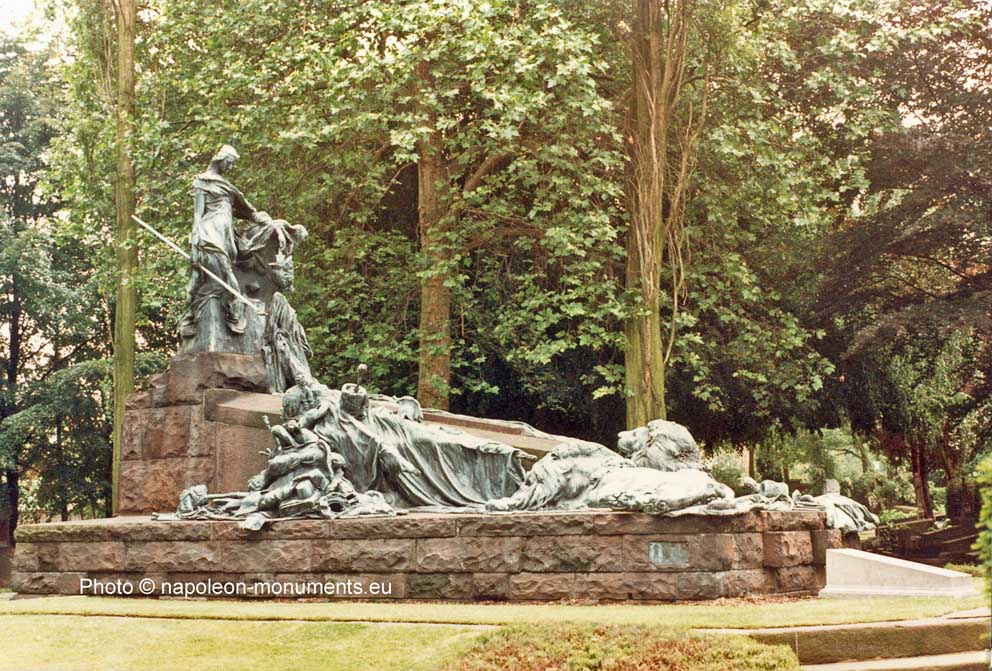
Britannia dominates the monument.

MORTUORUM
PATRIA MEMOR
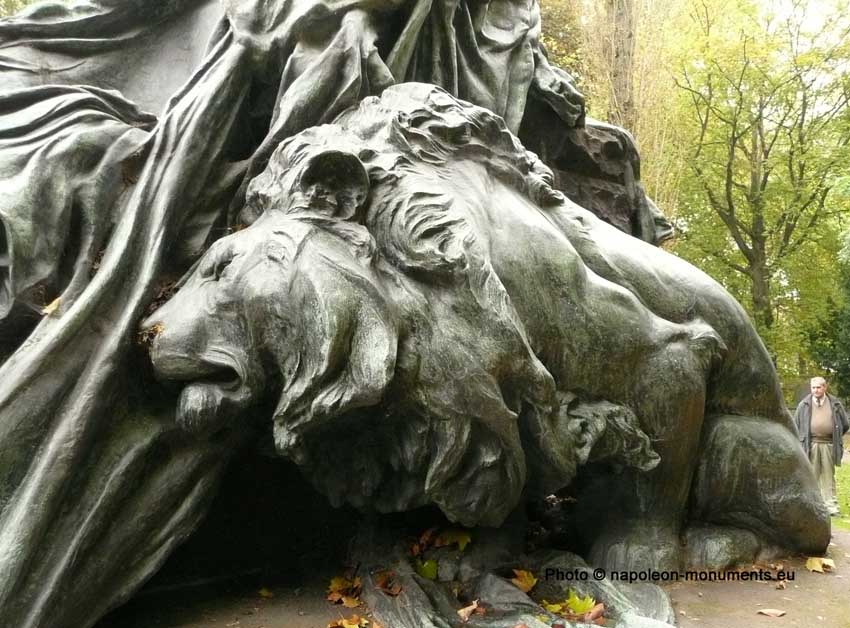
Two superb lions guard the monuments (while the third is sleeping !)*

Some details of the trophies ... One can only see pieces of British equipment, so these are not exactly trophies. French-British relations had improved, so probably it wasn't a good idea to show captured eagles...
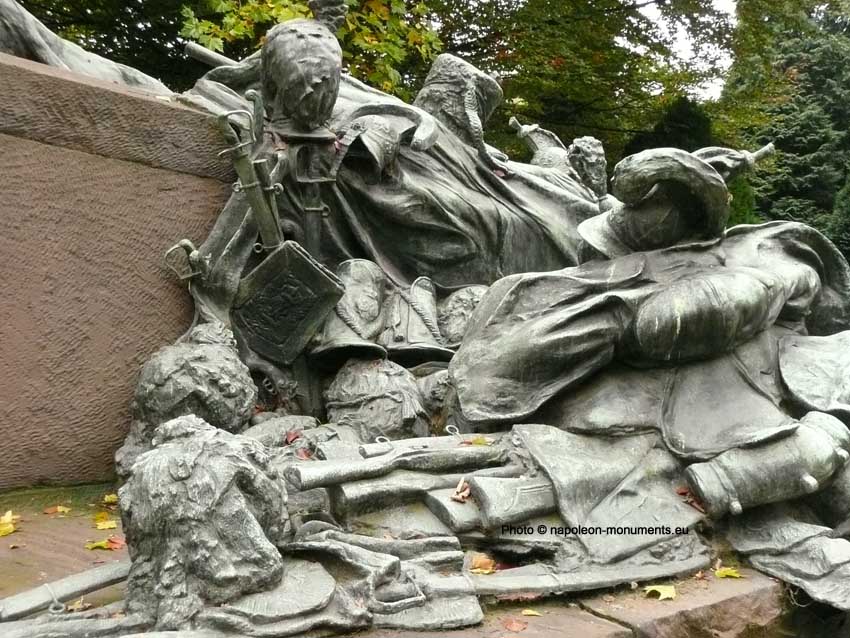
Colonel de Lancey's tombstone was placed in front of the monuments. This stone came from the Quartier-Léopold Cemetery.
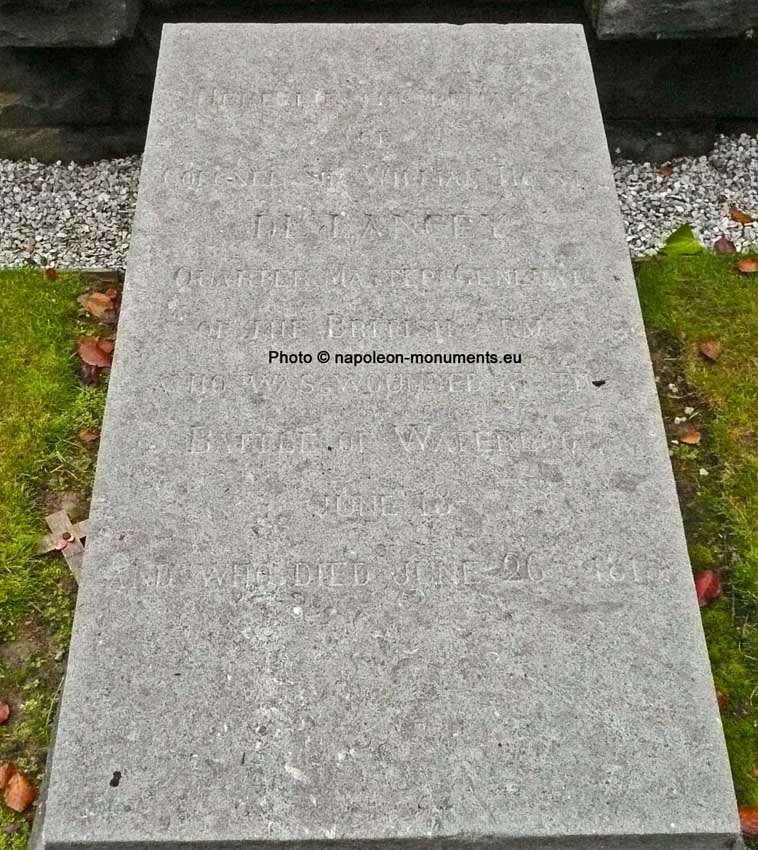 |
|
At the entrance of the crypt, two shields were placed, bearing the names of most British regiments who participated in the battle of Waterloo. One of the sheets has a some kind of head of a gorgon.
|
|
|
|
|
|
|
This inscription was placed above the entrance.
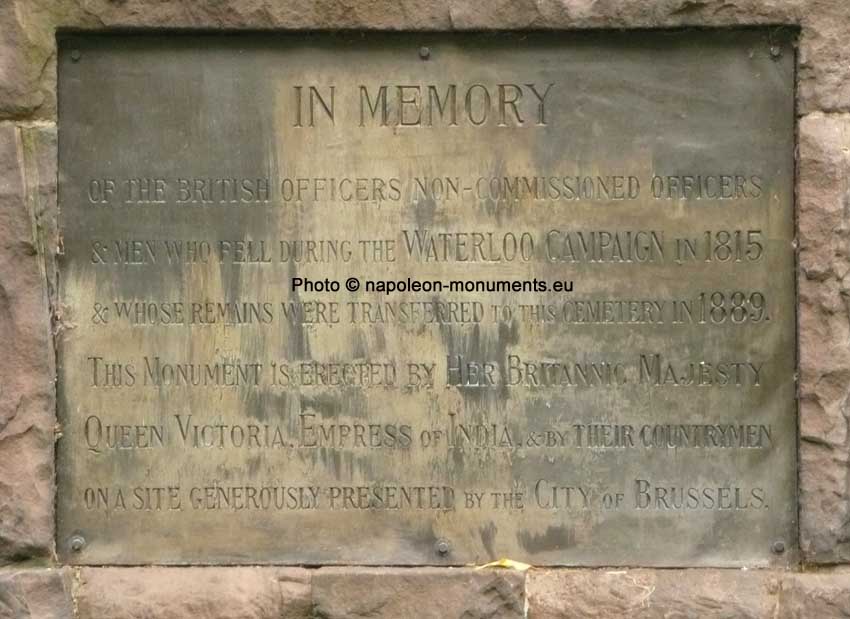 |
In Memory
& Men who
fell during the Waterloo Campaign in 1815
|
Let us follow this Old Guard Grenadier paying homage to his former enemies...
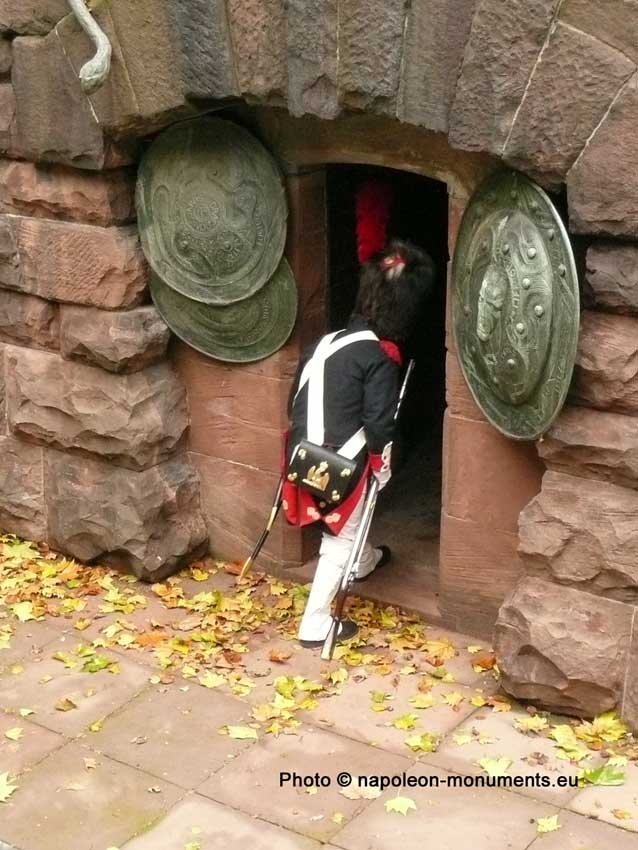
The crypt has 16 niches, one of them empty. Two niches contain two corpses,
so there are 17 corpses in all. Of these 17 soldiers, 4 where killed at Quatre-Bras (Grose,
Hay, Brown, Barrington). Twelve were killed or mortally wounded at Waterloo.
Only one, Cotton, died long after the battle, in 1849.
Eight corpses came from the Quartier-Léopold Cemetery (Cromie, Stothert,
Milnes, de Lancey, Lloyd, McLaine, Clyde and Spearman), 2 from Saint-Gilles
(Gordon and Forbes), 4 from Quatre-Bras (Grose, Hay, Brown and Forbes), where
they were buried on the edge of Boussu Wood, 2 from Hougoumont (Blackman
and Cotton) and 1 (Stables) from a garden in Waterloo.2a+b
Apparently, those buried in the cemetery of Waterloo (Ellis) or elsewhere (Fitzgerald, Heyland)
where forgotten, or left in place because one thought that they were safe.
Unfortunately, because of that, they were lost!
One important precision: the Quartier-Léopold Cemetery (also called the
cemetery of the Protestant church of Saint-Josse or cemetery of the Four
Parishes (cimetière des Quatre Paroisses) never was located at the place of
the present Quartier-Léopold station, but to the left of the chaussée de Louvain,
before arriving at the place Meiser ! It is also there that the little Joséphine
Napoléone de Montholon (probably Napoleon's last illegitimate child)
was buried. Thanks to M. Claude Van Hoorebeeck for all these precisions.
Further reading : two articles by Cl. Van Hoorebeeck :Blackman, John-Lucie: pourquoi sa tombe est-elle à Hougoumont ? published in the bulletin of the Association belge napoléonienne, n° 118, September-October 2007, pages 6 till 21
Du neuf à propos de la pierre tombale du capitaine John-Lucie Blackman. This article was published in the bulletin of the Association belge napoléonienne, n° 125, January-February 2009, pages 14 and 15.
Other 1815 tombs in Evere
- Tomb of Colonel
Miller, mortally wounded at Quatre-Bras
- (Lost?) tomb of Colonel von Langrehr, 1st Bremen Battalion
1) Lieutenant Colonel William Henry Milnes, 1st Royal Foot Guards
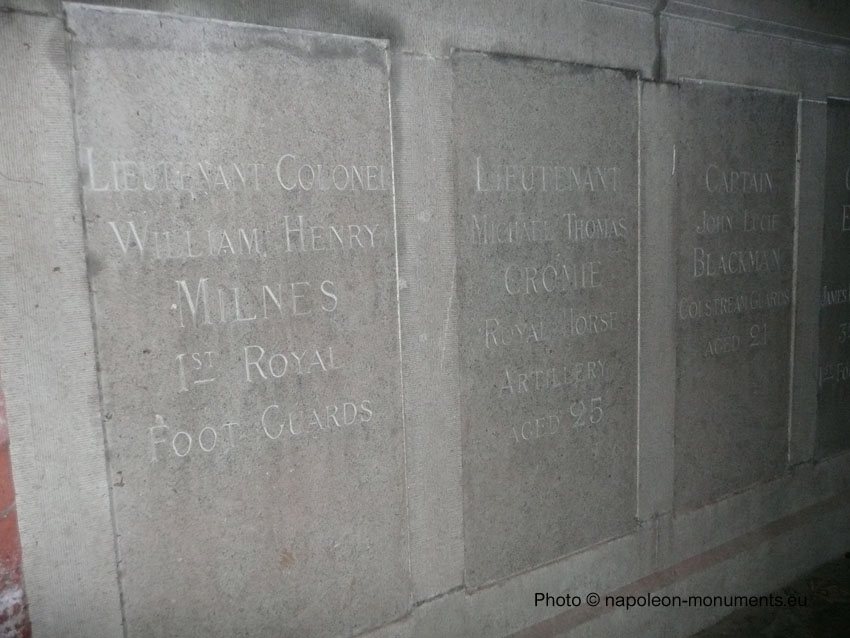 |
Lieutenant Colonel
Lieutenant |
Lieutenant-Colonel William Henry Milnes was born in 1788, second son of Sir Robert Milnes, Baronet, and of Charlotte, eldest daughter of Captain J. A. Bentinck, R.N.
Ensign at the 1st Foot Guards on 5 January 1805.
He takes part in the Peninsular War as a member of the first Battalion from
October1808 to January 1809. Lt & Capt on 4 May 1809. At the 2nd
battalions from March 1810 to May 1811 (Cadiz, Barossa). Aide de camp of lieutenant-general W. Bentinck
from June to September 1813. LtCol in his regiment on 25 July 1814.
He dies of his wounds on 20 June, 1815. His remains were transferred
from the Quartier-Léopold Cemetery on 8 February 1889 and buried in the crypt
on 29 July 1890. 2b
His name is mentioned on the
plaque to the 1st Foot Guards in the St-Joseph Church at Waterloo and on
the
Guards Officers Memorial in the Royal Military Chapel, Wellington Barracks,
London (near St-James's Park).
2) Lieutenant Michael Thomas Cromie, Royal Horse Artillery
See picture above.
Born in 1790 on Portstewart (Northern Ireland), 1st Lieutenant in the Regiment
on 25 January 1809.
He takes part in the Peninsular War from June 1813 to April 1814 as a member of D Troop, R.H.A., on command at I Troop. Present at the Battle of the Bidassoa, at Orthez, Toulouse, Tarbes.
In 1815, he belongs to Major Beane's D Troop. Had both his legs taken off by one shot, and died two days after, while undergoing amputation.
Is remains were transferred from the Quartier-Léopold Cemetery on 8 February 1889 and buried in the crypt on 29 July 1890.2b
His name is mentioned on the plaque to the fallen of the Artillery inside St-Joseph church in Waterloo
3) Captain John Lucie Blackman, Coldstream Guards
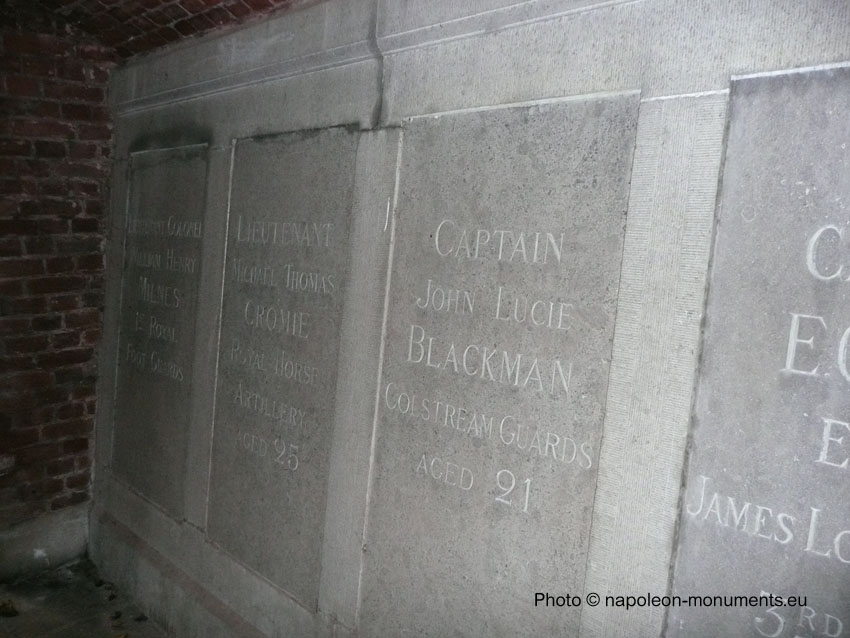 |
|
Born on 4 October 1793 in London, youngest son of Sir George Blackman, Bart., by
Mary, eldest surviving daughter of Lt.-col. Henry Harnage, of Belleawardine, Shropshire.
He takes part in the Walcheren expedition in 1809.
Ensign in the Coldstream Guards on 5 April 1810. He takes part in the Peninsular
War from February 1812 to March 1814 : Salamanca, Burgos, Vitoria,
Bidassoa, Nivelle, Nive, Adour, Bayonne.
In the Netherlands in 1814.
Lieutenant and Captain in the regiment on 11 January 1814. Killed in the defence of Hougoumont.
His tombstone, placed on the 1st December 1815 by Guillaume Rahlenbeck, where he was billeted, it is still present in the orchard of Hougoumont.
He was transferred to Evere on 30 July 1890.2b
He is mentioned on the Guards Officers Memorial in the Royal Military Chapel, Wellington Barracks, London (near St-James's Park).
Further reading : two articles by Cl. Van Hoorebeeck :
Blackman, John-Lucie: pourquoi sa tombe est-elle à Hougoumont ? published in the bulletin of the Association belge napoléonienne, n° 118, September-October 2007, pages 6 to 21
Du neuf à propos de la pierre tombale du capitaine John-Lucie Blackman. This article was published in the bulletin of the Association belge napoléonienne, n° 125, January-February 2009, pages 14 and 15.
4) Captain Edward Grose, 3rd Batt, 1st Foot Guards - Ensign James Lord Hay
A.D.C., 3rd Batt 1st Foot Guards
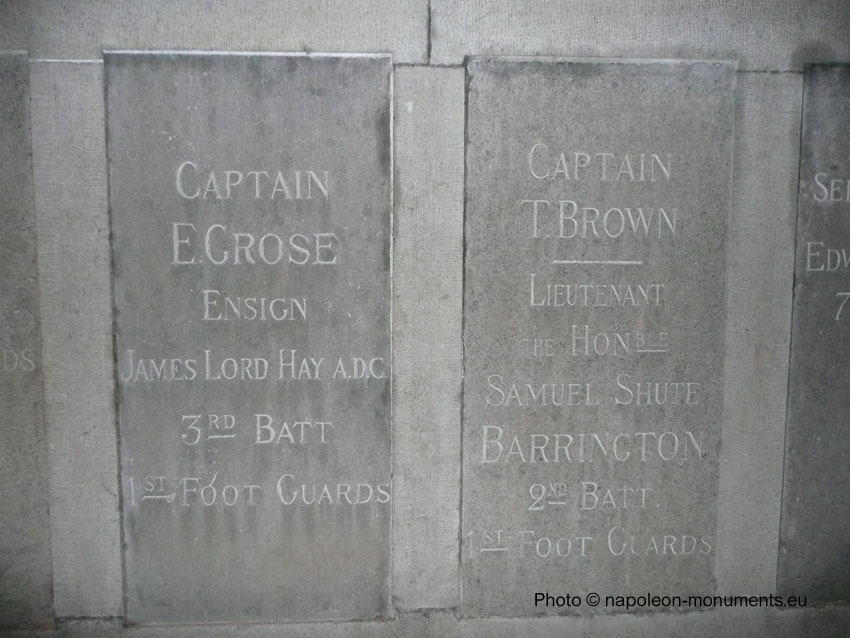 |
|
Edward Grose becomes Ensign in the 1st Foot Guards on 25 December 1805.
Lt and Captain in the Regiment on 26 September 1811.
He takes part in the Peninsular War as a member of the 3rd Battalion from October 1808 to January 1809 and from April 1811 to April 1814. He takes part in the Corunna campaign, is present at the battles of Cadiz, San-Sebastian, the Bidassoa, Nivelle, Nive, Adour, Bayonne. He was military secretary of General Cooke from July 1811 to May 1813.
Edward Grose was killed at Quatre-Bras.
James, Lord Hay, was born on 7 July 1797, eldest son of William, 16th Earl of
Errol, by his 2nd wife Alicia, youngest daughter of Samuel Eliot, of the
Island of Antigua.
Hay becomes Ensign in the 1st Foot Guards on 21 October
1813, but also aide-de-camp to Major-General P. Maitland. (He should not be
mistaken for Captain Lord James Hay, of the same Regiment, extra
aide-de-camp to Sir Charles Colville
In The History of the Grenadier Guards he is erroneously called " Lord James
Hay." The latter officer, also in the 1st Guards, lived for many years
afterwards.)
Despite his young age, he takes part in the Peninsular War as a member of the
third Battalion from March to April 1814 : present at the Battle of Bayonne.
Had ridden and won a race at the Grammont Races on 13th June, and was dead on the 16th. Was acting as adjutant to Lord Saltoun. His horse, a fine thoroughbred, refused a fence, and tried to wheel round. As Lord Saltoun was passing down a path close by, a body fell across his horse's neck and rolled off. It was poor Hay, who had been picked off by a French cavalry skirmisher, who was, in his turn, shot dead by a Grenadier.
Grose and Hay were both killed at Quatre Bras, buried on the spot near the Boussu Wood and transferred to Evere on 30 July 1880.2b
Their names are mentioned on the plaque to the 1st Foot Guards inside St-Joseph church in Waterloo and on the Guards Officers Memorial in the Royal Military Chapel, Wellington Barracks, London (near St-James's Park).
5) Captain Thomas Brown, 2nd Batt 1st Foot Guards - Lieutenant the Honble Samuel Shute
P.
Barrington, 2nd Batt, 1st Foot Guards
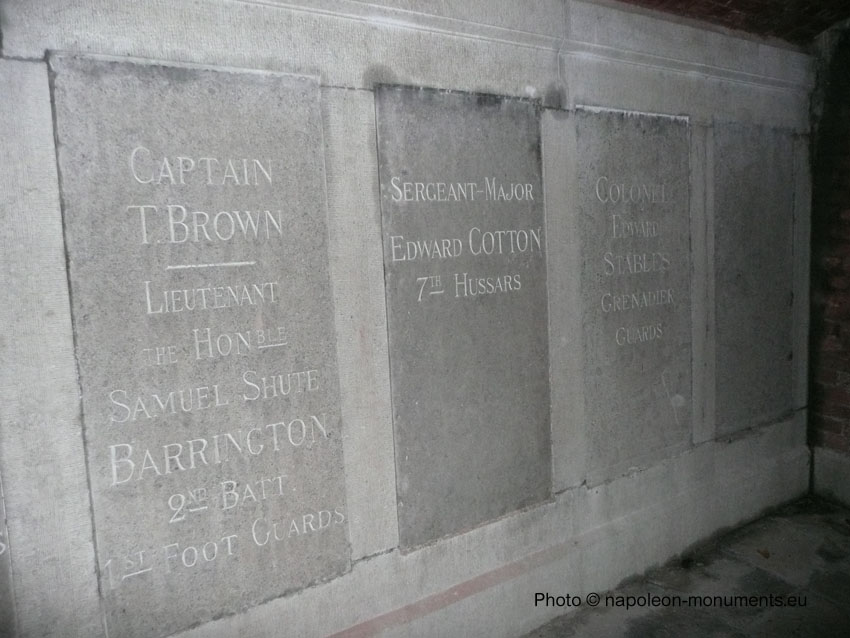 |
|
Thomas Brown belonged to the family of "Brown of Kingston Blount, co. Oxford."
He became a Lieutenant in the 79th Foot on 15 December 1807, after having
taken part in the expedition to the Baltic.
After that, it is the Peninsular War from July 1810 to April 1814 : Cadiz,
Bussaco (where he is slightly wounded - Gold Medal), Foz d'Arouce, Fuentes de
Oñoro (G.M.), Salamanca (G.M.), Burgos, les Pyrenees (G.M.), Nivelles (G.M.),
Nive (G.M.) and Toulouse.
Il becomes a Captain in the Regiment on 22 March 1814.
Samuel Barrington was Ensign since 7 September 1814 and in the Regiment since 24 November 1814. Third son of the Right Hon. and Rev. Lord Viscount Barrington, Prebendary of Durham, by Elizabeth, 2nd daughter of Robert Adair.
Both were killed at Quatre-Bras, buried on the spot and transferred here on 30 July 1880.2b
Their names are mentioned on the plaque to the 1st Foot Guards inside St-Joseph church in Waterloo and on the Guards Officers Memorial in the Royal Military Chapel, Wellington Barracks, London (near St-James's Park).
6) Sergeant-Major Edward Cotton, 7th Hussars
See picture above.
Cotton was born in the Isle of Wight on 20 January 1793. At Waterloo,
where he had a horse killed under him, it was still a soldier. He only later
became sergeant-major. After his military career, he became famous as a
battlefield guide on the battlefield of Waterloo, where he had settled. He was
well educated and wrote the famous
A Voice from Waterloo. He also created the first museum on the
battlefield. After his death, on 24 June 1849, the Museum was run by his
niece, at least until1875. At the Bivouac de
l'Empereur, one can still see the entrance of the place where his collections
where shown. When the collection web dispersed, a part of it was bought by the
Brussels Army Museum, another part went to the Wax museum near the lion mound.
Cotton enjoyed two privileges : he is not only the only NCO to be buried in
the crypt, but he is also the only one not killed or mortally wounded during
the 1815 campaign.
His tombstone still exist in the in the orchard of Hougoumont. He was transferred to Evere on 30 July 1890.2b
7) Colonel Edward Stables, Grenadier Guards
See picture above.
His complete biography
here
His tomb, which was restored in 1990,
is still present in the garden at the back of the house at the chaussée de Bruxelles
in Waterloo. One of the plaques of
his tomb is attached to a wall at the Wellington Museum.
He is mentioned on the plaque
to the 1st Foot Guards in the Waterloo church and on the
Guards Officers Memorial in the Royal Military Chapel, Wellington Barracks,
London (near St-James's Park). He was transferred to Evere on 13
December 1894.
8) Empty (foreseen for Miller)
At the far end of the crypt, against the wall: Plaque with a poem to the British heroes
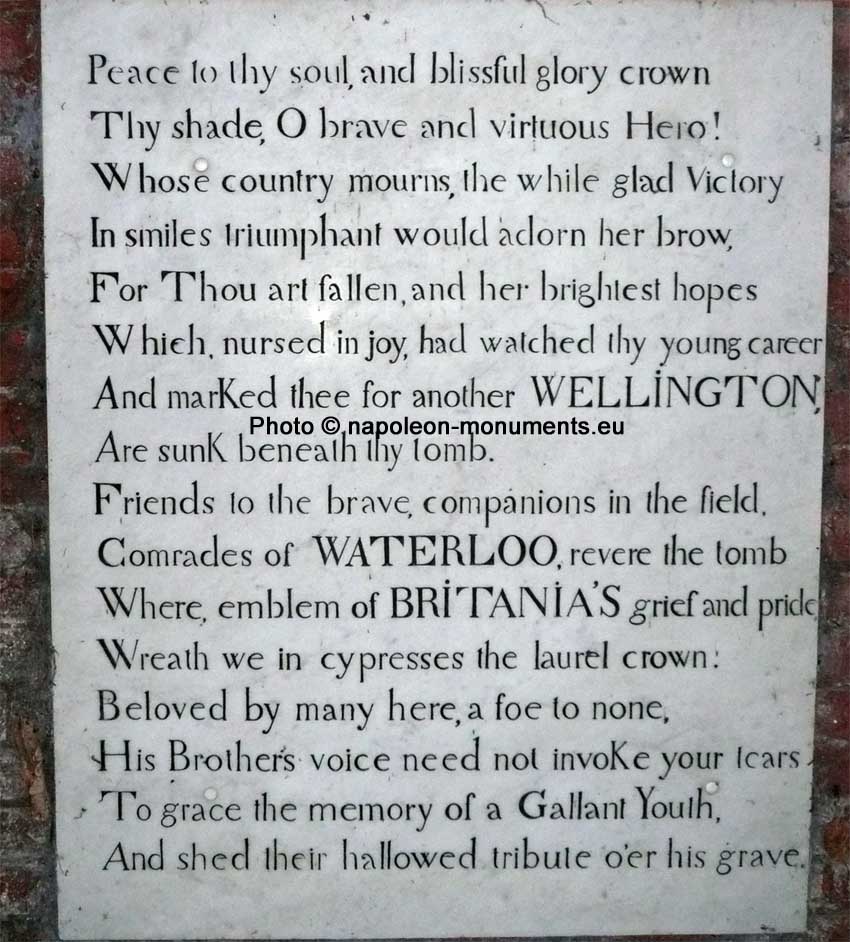 |
|
9) Captain the Honble Hastings Brudenell Forbes, 2nd Battalion, 3rd Royal Foot Guards
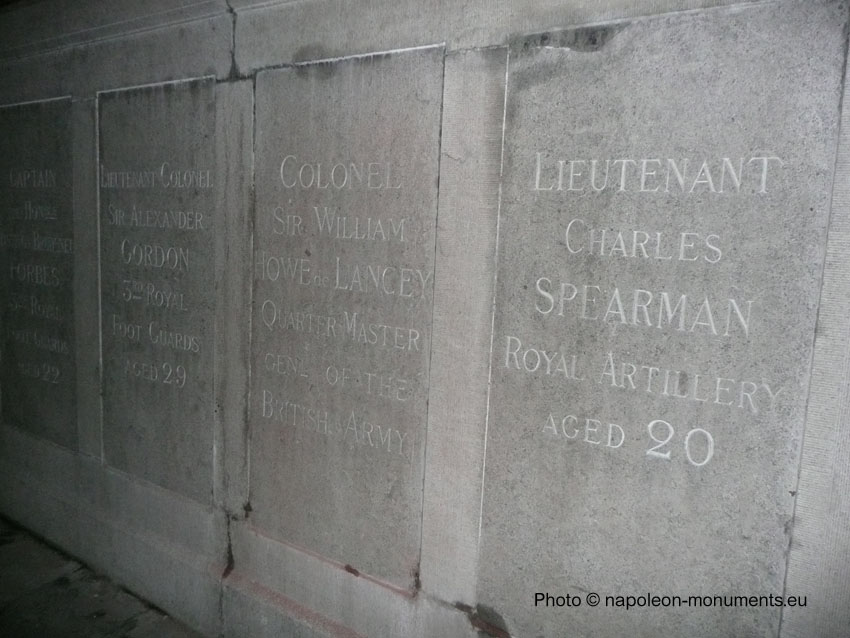 |
|
Forbes was born on 4, 5 or 25 December 1793 in Longford, Granard, 3rd son of George, 6th Earl of Granard, and of Selina, daughter of John, 1st Earl of Moira.
Ensign in the 3rd Foot Guards on 17 January 1811.
He takes part in the Peninsular War from July 1812 to April 1814 :
Burgos, Bayonne. Lieutenant and Captain in the Regiment on 5 May 1814.
His tombstone is preserved to the left of the staircase leading to the crypt, but it is nearly completely unreadable .
Forbes was transferred from the Saint-Gilles Cemetery (Fort Monterey - there is still a rue du Fort there), temporarily to Evere on 28 May 1889, and interred in the crypt on 25 July 1890.2b
His name is mentioned on the plaque to the Officers of the 2nd Battalion / 3rd Foot Guards in the Waterloo church and on the Guards Officers Memorial in the Royal Military Chapel, Wellington Barracks, London.
10) Lieutenant-Colonel Sir Alexander Gordon, 3rd Royal Foot Guards
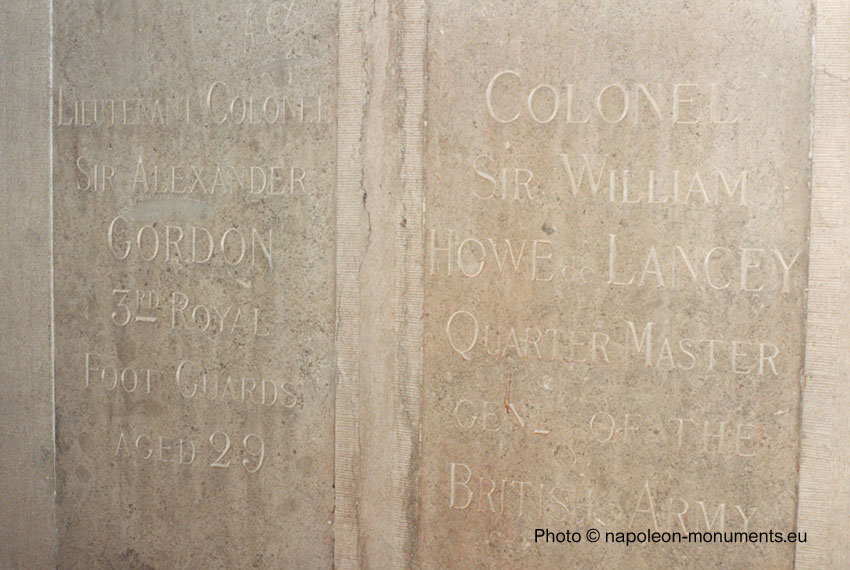 |
|
Gordon's tombstone is preserved at the right of the staircase leading to the crypt. Of course, everybody knows his column on the Waterloo battlefield.
Like Forbes, he was transferred from the Saint-Gilles Cemetery (Fort Monterey), temporarily to Evere on 28 May 1889, and interred in the crypt on 25 July 1890.2b
His name is mentioned on the plaque to the Officers of the 2nd Battalion / 3rd Foot Guards in the Waterloo church and on the Guards Officers Memorial in the Royal Military Chapel, Wellington Barracks, London.
11) Colonel Sir William Howe de Lancey, Quarter Master General of the British Army
See picture above.
De Lancey was born in 1778 in New-York, or in 1781 or 1783 (in England), according to
various sources, descendant
of French Huguenots. His life is well known, for that reason, we shall not go
into further details here. Some interesting information
here.
He was at the side of the Duke of Wellington when he was mortally wounded. The
Duke told the following story :
"De Lancey was with me, and speaking to me when he was struck. We were on a point of land that overlooked the plain. I had just been warned off by some soldiers (but as I saw well from it, and two divisions were engaging below, I said "Never mind"), when a ball came bounding along en ricochet, as it is called, and, striking him on the back, sent him many yards over the head of his horse. He fell on his face, and bounded upwards and fell again. All the staff dismounted and ran to him, and when I came up he said, "Pray tell them to leave me and let me die in peace". I had him conveyed to the rear, and two days after, on my return from Brussels, I saw him in a barn, and he spoke with such strength that I said (for I had reported him killed), "Why! De Lancey, you will have the advantage of Sir Condy in ‘Castle Rackrent’—you will know what your friends said of you after you were dead". "I hope I shall", he replied. Poor fellow! We knew each other ever since we were boys. But I had no time to be sorry. I went on with the army, and never saw him again."
Recollections of Samuel Rogers
De Lancey died of his wounds on 26 June 1815, in spite of the care of his young wife, in a house more or less on the number 2 of the chaussée de Charleroi at Braine l'Alleud.
His tombstone is preserved in front of the monument. De Lancey was transferred from the Quartier-Léopold Cemetery on 8 February 1889 and interred in the crypt on 29 July 1890.
12) Lieutenant Charles Spearman, Royal Artillery
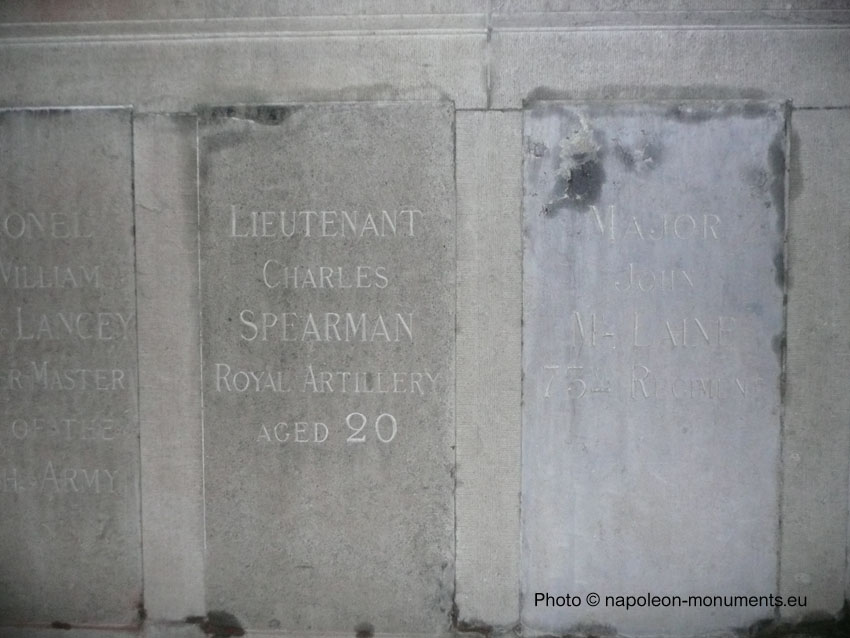 |
|
Charles Spearman was born on 14 (or 18 ?) November 1791, eldest son of Charles Spearman, of Thornley Hall, co. Durham, by Sarah, daughter and heir of Samuel Brooke, of Birchington, Kent.
He becomes a Lieutenant in the Regiment on 30 August 1812.
Mortally wounded at Waterloo, he dies at Brussels on 28 (or 27) June 1815,
aged 24 and not 20. His remains
were transferred from the Quartier-Léopold Cemetery on 8 February 1889 and
buried in the crypt on 29 July 1890.2b
His name is mentioned on the plaque
to the fallen of the Artillery inside St-Joseph church in Waterloo.
He seems to have been forgotten in the Peninsula Roll Call.
13) Major John Archibald MacLaine, 73rd (Highland) Regiment of Foot
See picture above.
John MacLaine is born on 16 June 1778, fourth son of Gilbert Maclaine, of Scalasdale,
Isle of Mull.
He becomes a major in his Regiment on 28 May 1812.
Mortally wounded at Waterloo, he dies in Brussels.
His remains were transferred from the Quartier-Léopold Cemetery on 8 February 1889
and buried in the crypt on 29 July 1890.2b
He is not mentioned in the Peninsula Roll Call.
14) Captain William Stothert, 3rd Royal Foot Guards and Brigade Major to the 2nd Brigade of Guards
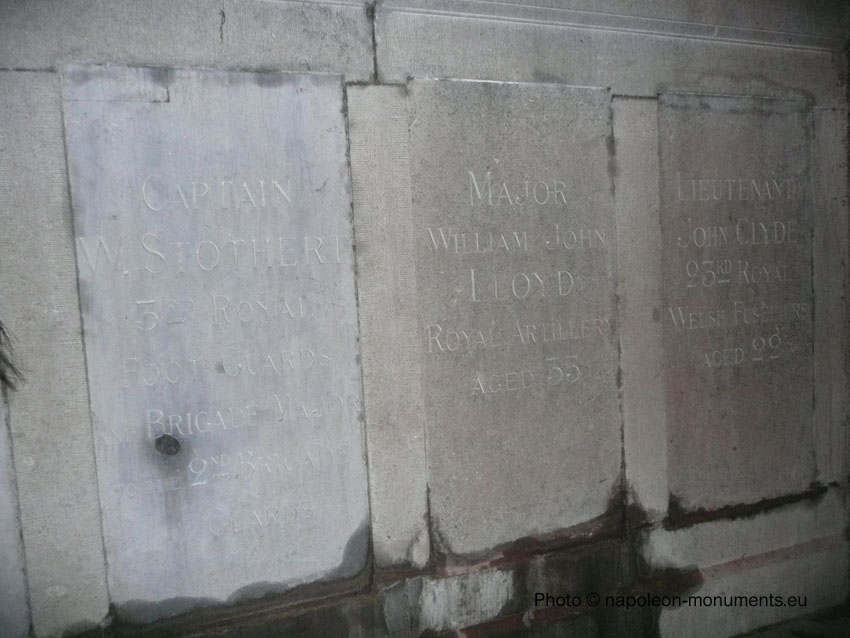 |
|
From Kirkcudbrightshire, William Stothert was born in 1780 in Dumfries, in Scotland. He had become an Ensign in the 3rd Foot Guards on 30 October 1805, Adjutant on 25 August 1809, Lieutenant and Captain on 4 April 1811.
He serves in the Peninsula from March 1809 to January 1812 : Douro, Talavera, ?, Fuentes de Oñoro.
After that, he goes to the northern front and is severely wounded at the
assault of
Bergen-op-Zoom
in March 1814.
At Waterloo, he is mortally wounded and dies on 23 June 1815.
His remains were transferred from the Quartier-Léopold Cemetery on 8 February 1889
and buried in the crypt on 29 July 1890.2b
His name is mentioned on the plaque to the Officers of the 2nd Battalion / 3rd Foot Guards in the Waterloo and on the Guards Officers Memorial in the Royal Military Chapel, Wellington Barracks.
15) Major William John Lloyd, Royal Artillery
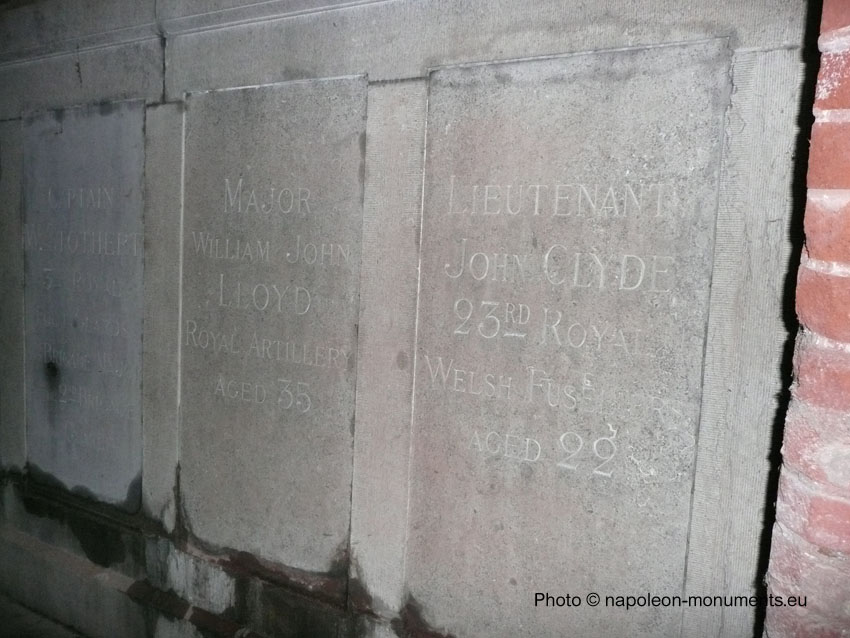 |
|
William John Lloyd is born on 2 December 1778. He was the son of Maj. John Lloyd,
of the 46th Foot, A.D.C. to Sir H. Clinton during the war in America, and of Corbetta,
daughter of the Ven. George Holcombe, Archdeacon of Carmarthen.
Captain in the Regiment on 13 June 1807 and Major on 4 June 1814. He was
commander of a foot artillery battery under command of LtCol
Williamson (3rd Division of Alten).
He died on the 29th of July 1815 at Brussels from wounds received at Waterloo
at the age of 37 and not, as stated, 35.
His remains were transferred from the Quartier-Léopold Cemetery on 8 February 1889
and buried in the crypt on 29 July 1890.2b
His name is mentioned on the plaque to the fallen of the Artillery inside St-Joseph church in Waterloo
He is not mentioned in the Peninsula Roll Call and should not be mixed up with John William Lloyd, another artillery officer, who died in 1825.
16) Lieutenant John Clyde, 23rd Royal Welsh Fusiliers
See picture above.
Born on the 27 February 1796 (in 1793 according to other sources). Second-Lieutenant in the 23e Foot on 20 June 1811, Lieutenant in
this same Regiment on 14 May 1812.
He serves in the Peninsula as a member of the first Battalion of this Regiment
from May 1812 to October 1813, and goes back to the Peninsula in April 1814.
He takes part in the Battle of Salamanca.
Mortally wounded at Waterloo, he dies of his woods at an unknown date.
His remains were transferred from the Quartier-Léopold Cemetery on 8 February 1889 and buried in the crypt on 29 July 1890.2b
Facing the entry of the crypt, two tombstones of officers buried inside the crypt where placed.
Gordon's tombstone.
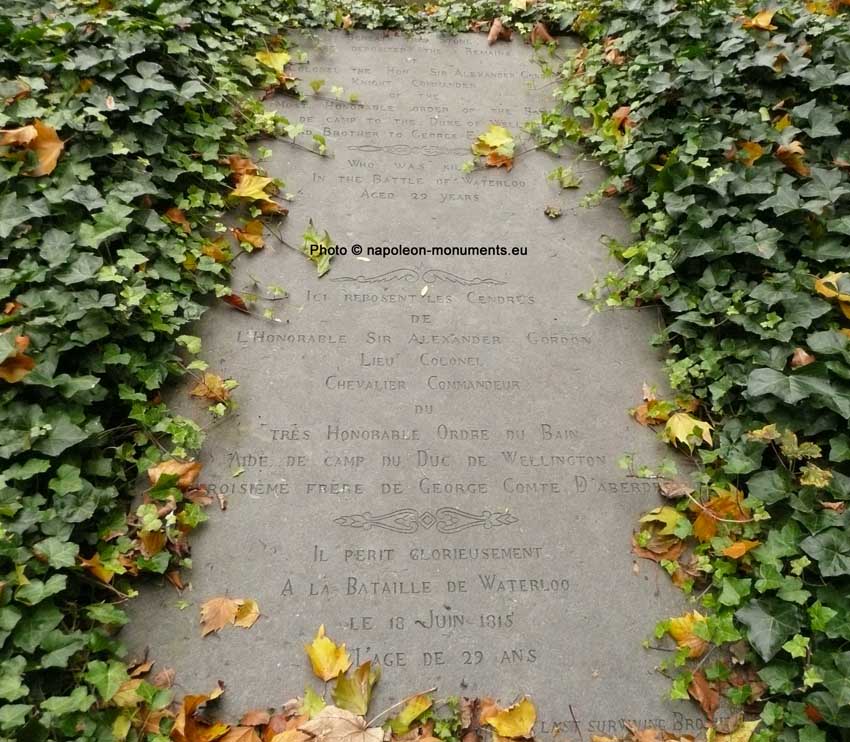 |
BENEATH THIS STONE
ICI REPOSENT LES CENDRES RESTORED BY ADMIRAL
THE HONBLE JOHN GORDON HIS LAST SURVIVING BROTHER |
Unfortunately, we have been able to decipher this stone. For that reason, we cannot give you the text, but it is most probably Forbes tombstone.3
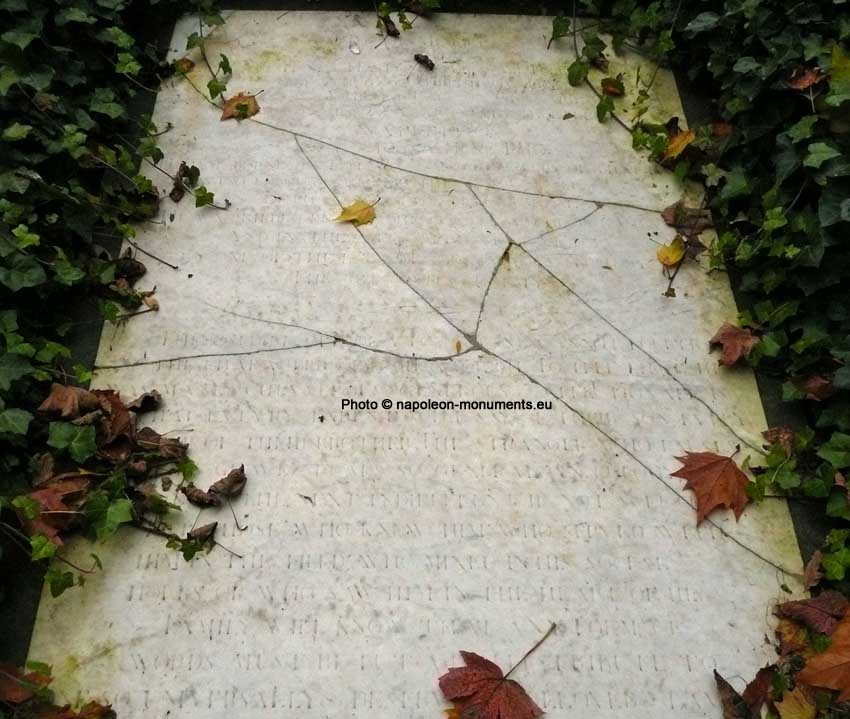
On this stone, just underneath the one above, Forbes's name can be clearly
read.
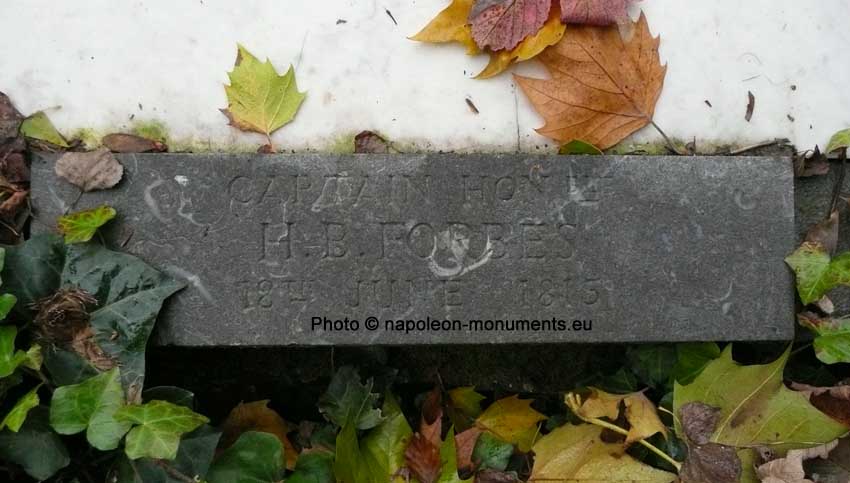 |
|
17) Tomb of Colonel William Miller, 1st Foot Guards, mortally wounded at Quatre-Bras
William Miller was 2nd son of Sir William Miller, Bart, (a lord of session by title of Lord Glenlee), by Grizel, daughter of George Chalmers, of co. Fife.
Lieutenant and Captain in the 1st Foot Guards on 31 July 1806, Adjutant on 2
October 1806, Captain and Lieutenant-Colonel on 3 March 1814.
He takes part in the Peninsular War as Deputy Assistant Adjutant General from
August 1808 to January 1809 (Corunna campaign). At the 3rd Battalion from July 1811
to March 1814.
Brigade Major in Lambert's Brigade from December 1811 to September 1812 and of
the
1st Brigade of the 1st Division from November 1812 to March 1814. He takes
part in the fighting at Cadiz, on the Bidassoa, Nivelle, Nive, Adour and at Bayonne.
On being wounded at the Quatre-Bras, he sent for his friend, Col. C. Thomas
(would be killed two days later), and said, " I feel I am mortally wounded,
but I am pleased to think it is my fate rather than yours, whose life is
involved in that of your young wife." After a pause, he said : " I should like
to see the colours of the Regiment before I quit them for ever." They were
brought and waved round his wounded body. " His countenance brightened, he
smiled, declared himself well satisfied, and was carried from the field."
He dies of his wounds in Brussels on the 17th of June (and not on the 19th, as
mentioned as well in the Peninsula as in the Waterloo Roll Call).
His name is mentioned on the plaque to the 1st Foot Guards inside St-Joseph church in Waterloo and on the Guards Officers Memorial in the Royal Military Chapel, Wellington Barracks, London.
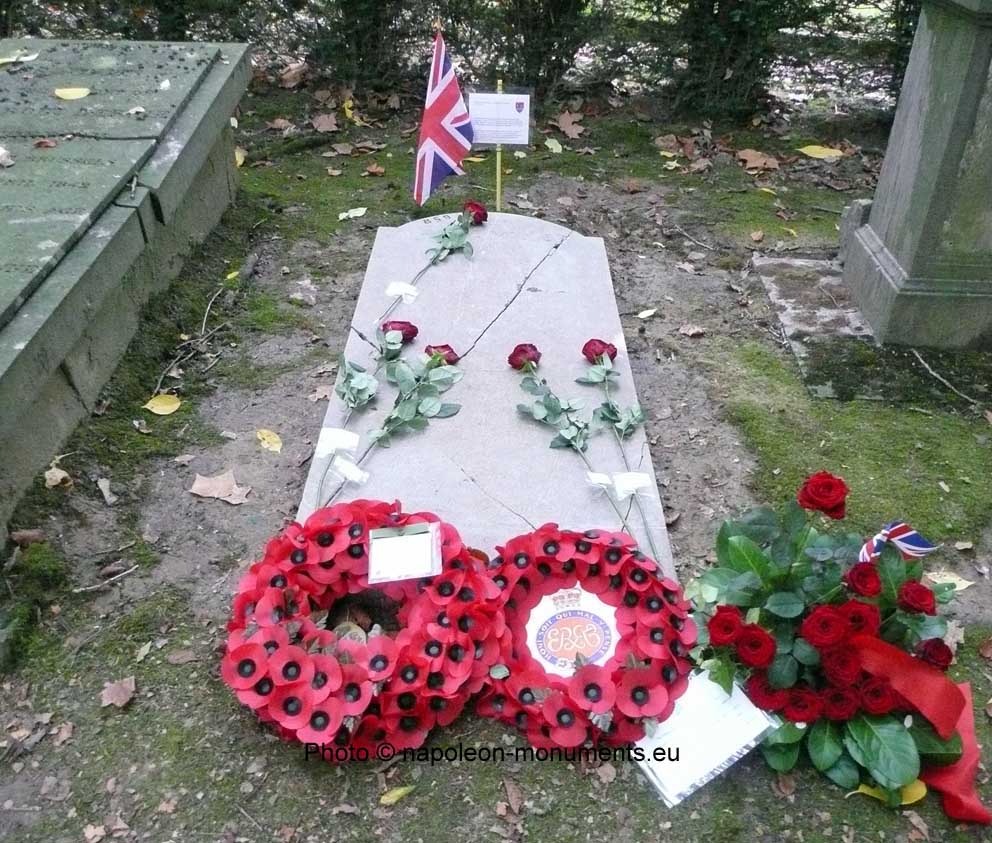 |
The remains of |
|
Erected in 1816 To record the Valour Of those British, Belgian And Prussian soldiers Who under WELLINGTON and BLUCHER On the 18th of June, 1815 Gained the Victory Of WATERLOO By which French Tyranny Was overthrown And Peace restored To the World |
Ceremony on his tomb: follow this link. Unfortunately, in spite of the care and precautions, the stone was broken.
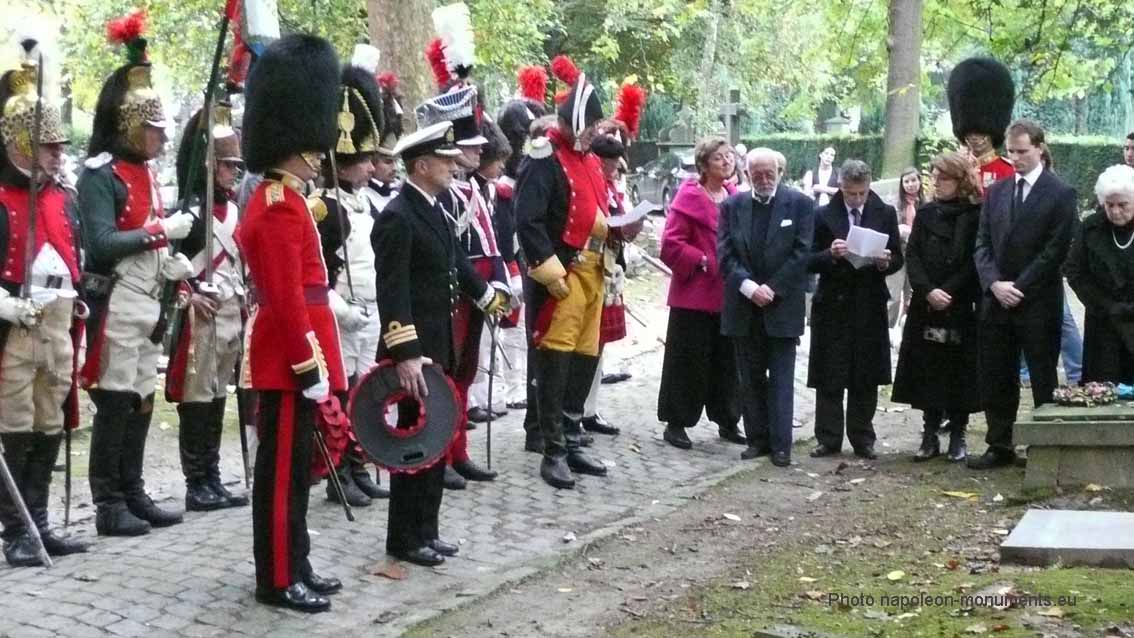
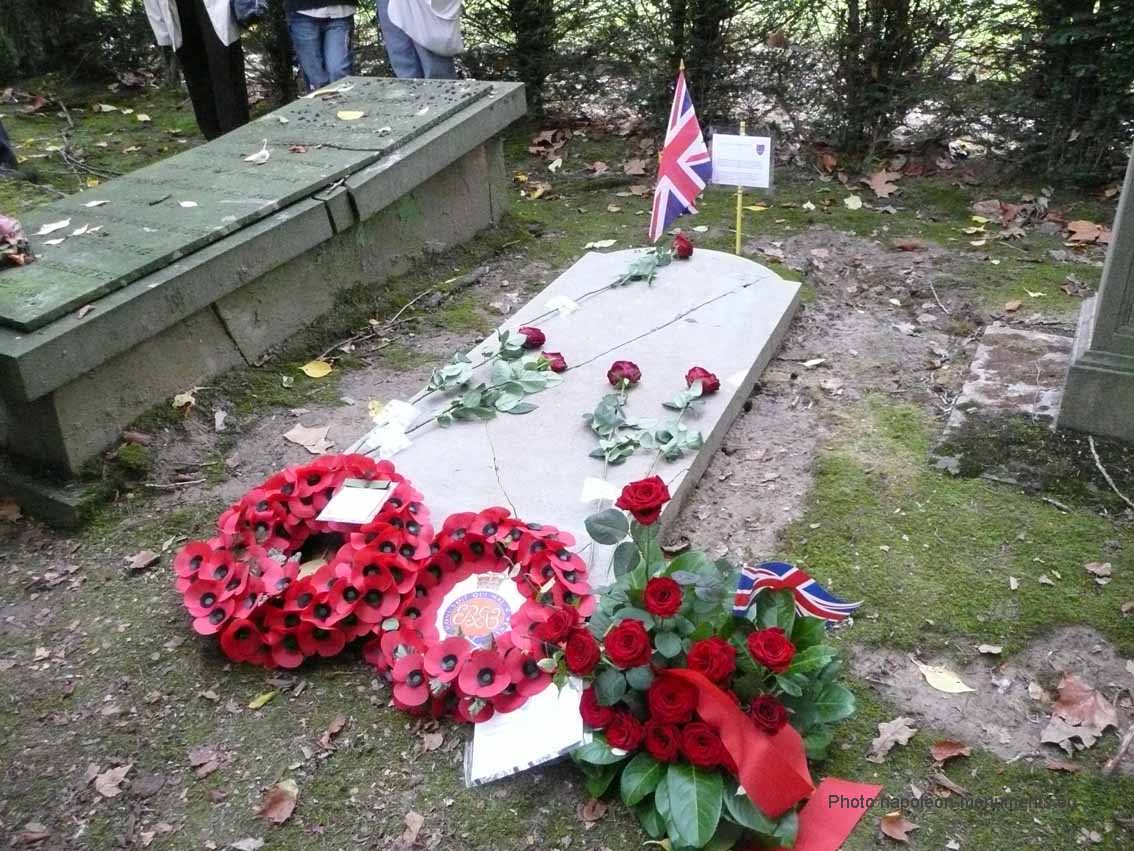
18) (Lost) tomb of Colonel Wilhelm Ludwig von Langrehr, 1st Bremen Battalion
Some sources say that a Hanoverian officer, colonel von Langrehr, commander of
the 1st Bremen Battalion4, buried in the Waterloo Cemetery,
has been transferred to Evere.
Wilhelm Ludwig von Langrehr was born on the 6th of June 1775 in Krietenstein
near Burkhausen (district of Melle in Saxony). He was in command of the 1st Feldjäger
Battalion (Feldbataillon Bremen, 1st Brigade (Kielmansegge).
5
The stone bore the inscription:
D.o.M
Ici repose le colonel de Langrehr,
Commandant du premier bataillon de Bremen
blessé à mort à la bataille de Waterloo
le 18 juin 1815 et enterré le lendemain
âgé de 40 ans.
R.i.P.
Any information on this subject would be most welcome.
* Many thanks to Mr Claude Van Hoorebeeck for the precious information he gave us for this page and for the corrections.
Most biographies were taken or compiled from :
- Dalton, Charles, The Waterloo Roll Call, with biographical notes and
anecdotes, Eyre and Spottiswoode, London, 1904.
and
- Challis, Lionel S., Peninsula Roll Call. 1949. The Napoleon Series.
December 2011. < www.napoleon-series.org >
Further reading : two articles by Cl. Van Hoorebeeck :
Blackman, John-Lucie: pourquoi sa tombe est-elle à Hougoumont ? published in the bulletin of the Association belge napoléonienne, n° 118, September-October 2007, pages 6 to 21
Du neuf à propos de la pierre tombale du capitaine John-Lucie Blackman. This article was published in the bulletin of the Association belge napoléonienne, n° 125, January-February 2009, pages 14 and 15.
------------------------------------------------------------------------------------------------------------------------------------------------------------------------------------------------------------------------------------------------------
1. Cecilia Vandervelde, La nécropole de Bruxelles, Bruxelles, 1991.
2.a Cl. Van Hoorebeeck, Blackman, John-Lucie: pourquoi
sa tombe est-elle à Hougoumont ? published in the bulletin of the Association belge napoléonienne, n° 118,
September-October 2007, pages 6 to
21.
2.b Cl. Van Hoorebeeck, Du neuf à propos de la pierre tombale du capitaine John-Lucie Blackman This article was published in the bulletin of the Association belge napoléonienne, n° 125, January-February 2009, pages 14 and 15.
3.C. Vandervelde, ibid..
4. G. Speeckaert and I. Baecker, Les 135 vestiges et monuments commémoratifs des combats de 1815 en Belgique, Waterloo, relais de l'histoire, 1990, p. 65. (Also available in English)
5.Claude Van Hoorebeeck, Les deux seuls enterrements dans le cimetière de Waterloo d'officiers tués lors des combats du 18 juin 1815 : le major baron Charles de Villers et le lieutenant colonel Richard FitzGerald, bulletin of the Société belge d'études napoléoniennes, n° 51, December 2007, pages 43 to 57.
------------------------------------------------------------------------------------------------------------------------------------------------------------------------------------------------------------------------------------------------------
Bibliography :
- An, The Waterloo Medal Roll, compiled from the Muster Rolls, The Naval and Military Press, 1992.
- Mark Adkin, The Waterloo Companion, Aurum Press, 2001.
- Alain Arcq, Les Quatre-Bras, le second prélude à Waterloo, in the collection "Les batailles oubliées", Historic'One Editions, 2005.
- Alain Arcq, Ligny, 16 juin 1815, La dernière victoire de l'Empereur, in the collection "Les batailles oubliées", Historic'One Editions, 2006.
- Alain Arcq, Wavre & le combat de Namur L'épilogue de la campagne de Belgique, in the collection "Les batailles oubliées", Historic'One Editions, 2008.
- Barral, Georges, Itinéraire illustré de l'épopée de Waterloo, guide
historique et militaire du champ de bataille, avec les diagrammes de l'auteur
et 60 dessins originaux d'Adolphe Hamesse. Flammarion, Paris, 1896.
- Alain CHAPPET - Roger MARTIN - Alain PIGEARD, Le Guide Napoléon - 4000 lieux
pour revivre l'épopée, Bibliothèque Napoléonienne, Tallandier, 2005.
- Dalton, Charles, The Waterloo Roll Call, with biographical notes and
anecdotes, Eyre and Spottiswoode, London, 1904.
- Yann Deniau et Yves Moerman, 1815 - Napoléon en Campagne,
Jourdan éditeur, 2008.
- Peter Hofschröer, Waterloo 1815 - Quatre-Bras & Ligny, Pen & Sword, 2006.
- Peter Hofschröer, Waterloo 1815 - Wavre, Plancenoit & the race to Paris, Pen & Sword, 2006.
- André Sevrin and Alain Arcq, Route Napoléon 1815 (ouvrage collectif coordonné par), Edition Unité de projet "Route Napoléon 1815", s.d..
- G. Speeckaert and I. Baecker, Les 135 vestiges et monuments
commémoratifs des combats de 1815 en Belgique, Waterloo, relais de
l'histoire, 1990. Exists also in English.
- Mr. Claude Van Hoorebeeck's website :
http://www.freepub.be/waterloo.php
- Van Neck, Léon, Waterloo met afbeeldingen, Lebègue, Brussel, s.d (around 1905).
